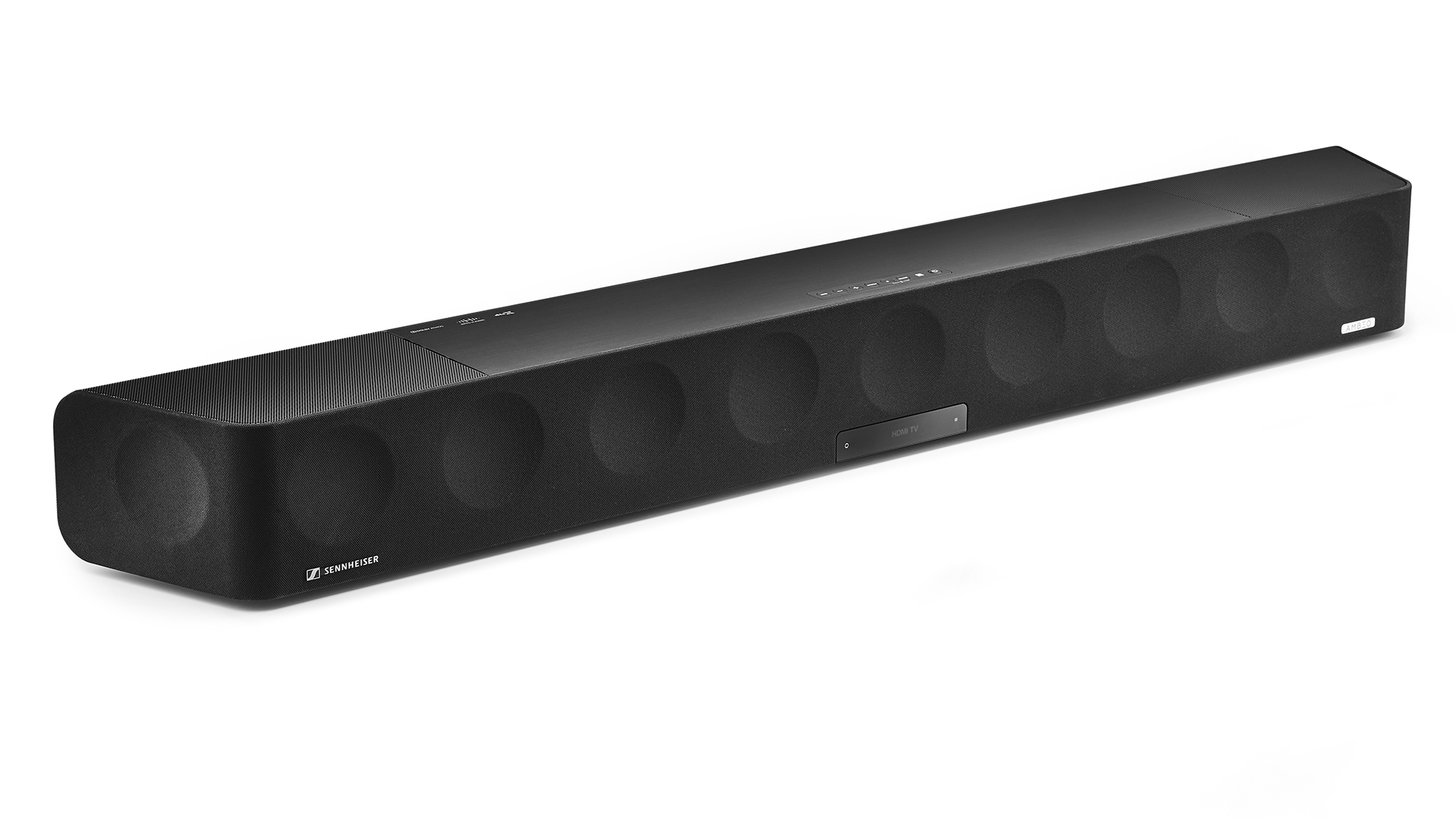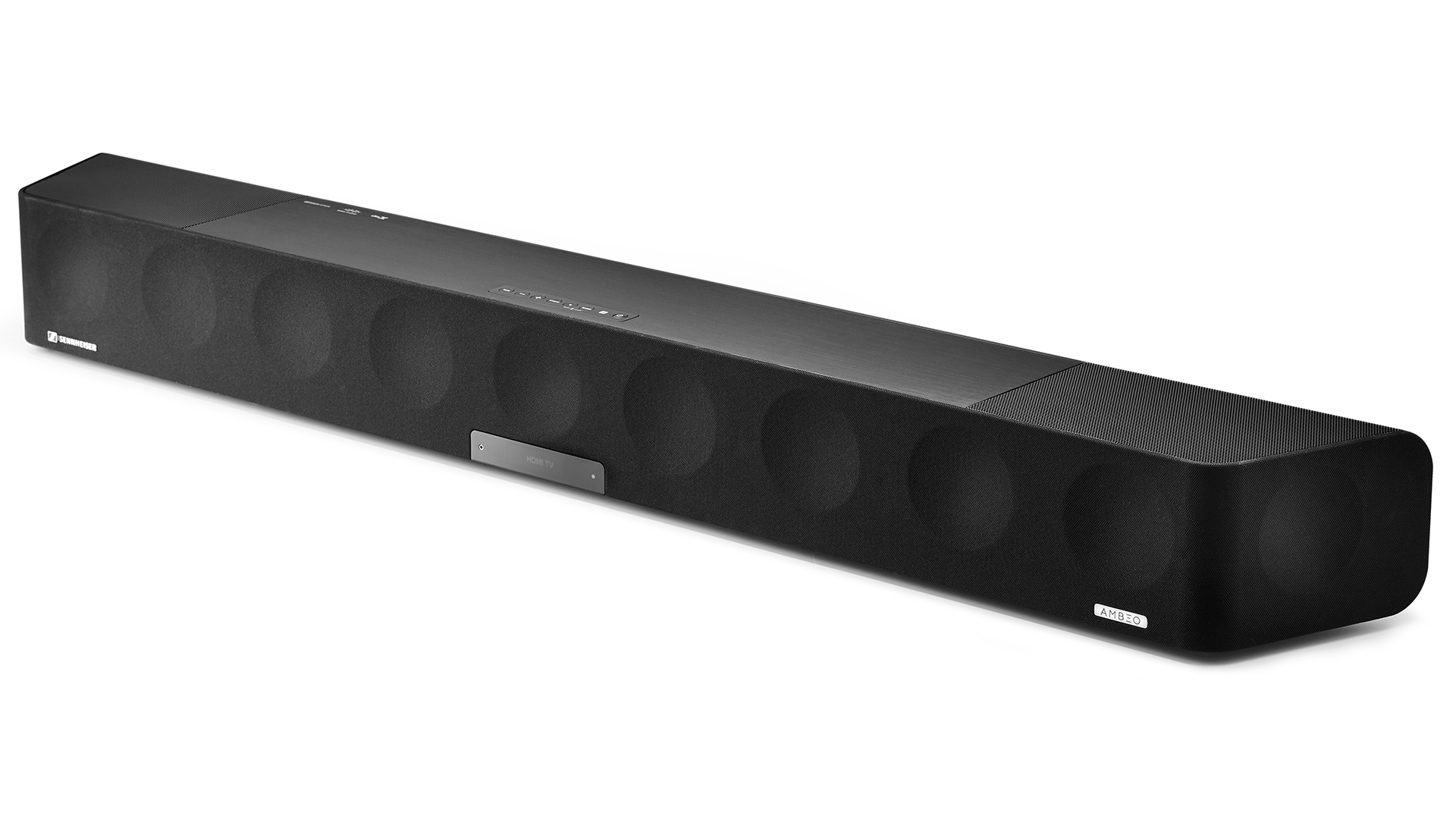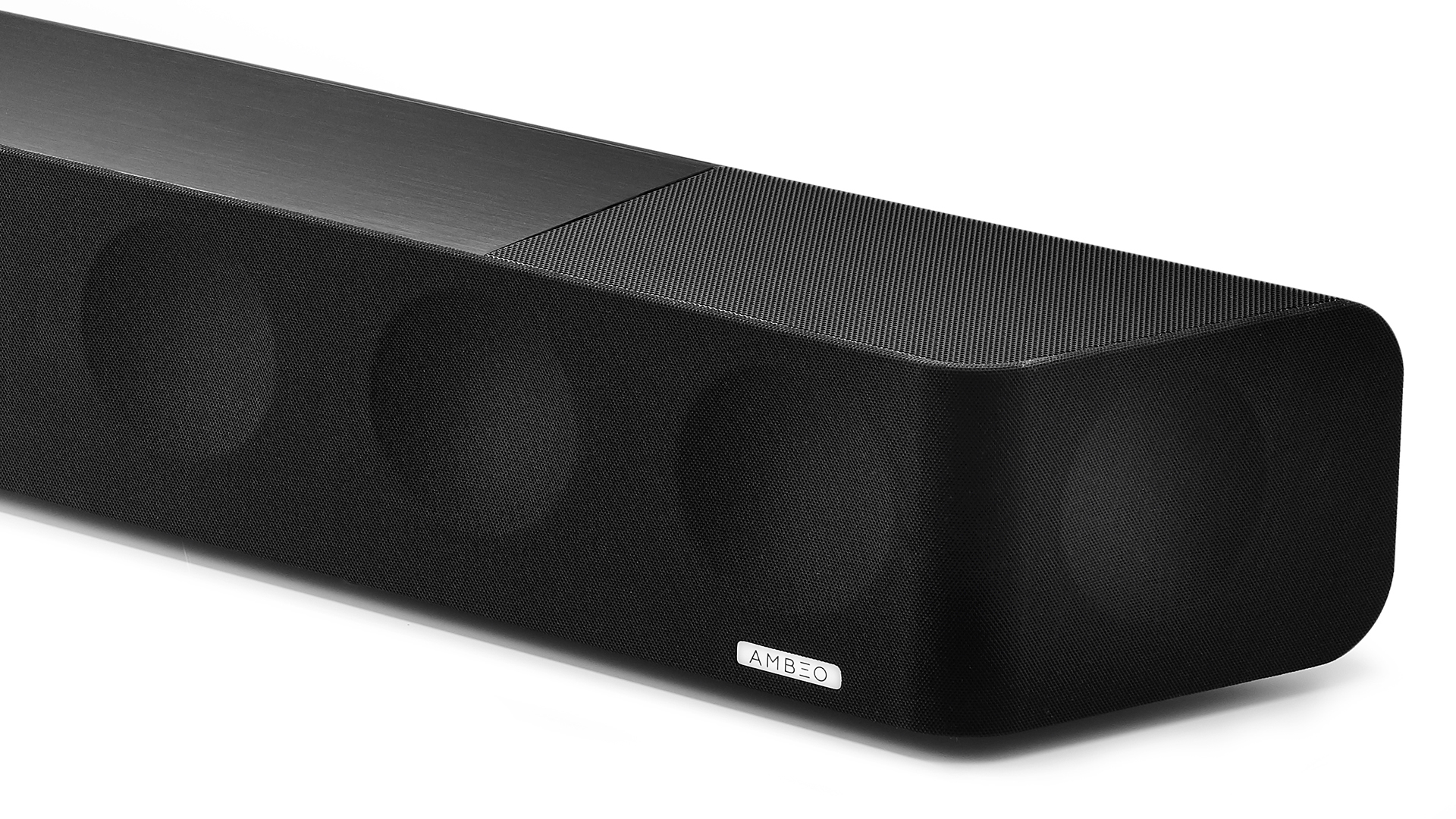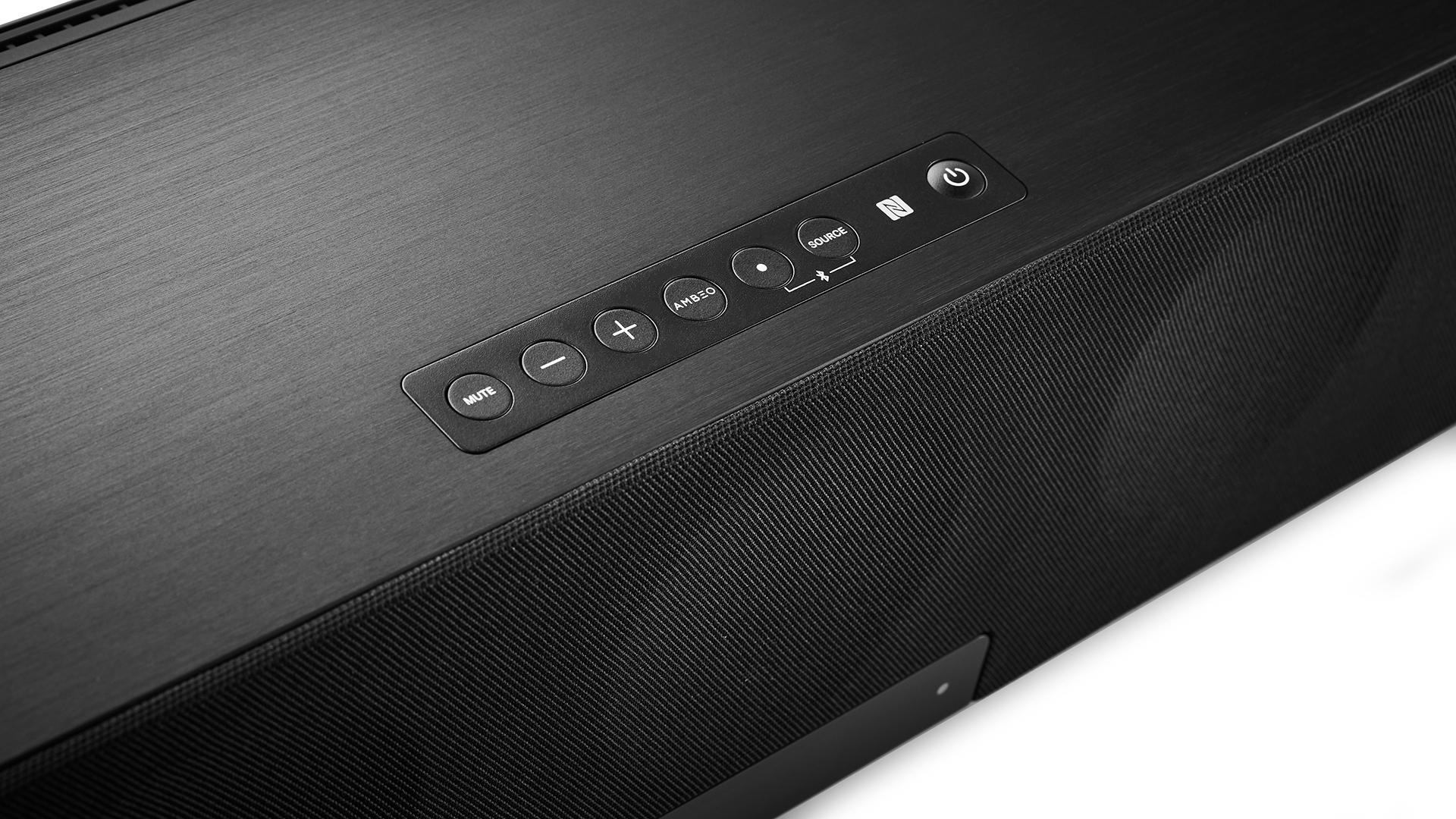
Amongst the legions of headphones that make up Sennheiser's domestic audio offering, one device has for a long time stuck out from all the rest. The original Ambeo soundbar, recently renamed Ambeo Soundbar Max, was always an anomaly within its own brand's product line-up, and even now that it finally has a sibling, it remains uniquely distinct from pretty much every other home cinema sound product on the market.
As a 77-year-old company with a fair bit of clout attached to its name, it's surprising that for a long time Sennheiser resisted the urge to release any type of loudspeaker, be it Bluetooth, smart or multi-room. That changed in 2020 when the increased accessibility of Dolby Atmos technology and content led it to venture into the world of soundbars, unleashing the behemoth that is Ambeo onto an unsuspecting public. With its 13 front, side and upward-facing drivers, the Sennheiser Ambeo Soundbar Max delivers a generous 5.1.4 channels of Dolby Atmos sound and exemplifies the 'go big or go home' attitude found in much of the company's pro audio equipment.
At the time of its release, and even more so now, there were already plenty of other Dolby Atmos soundbars available. However, the Sennheiser Ambeo Soundbar was, and remains, something a bit different. For starters, it's much more expensive than almost every other soundbar on the market, both single speaker and multi-box. It's also much bigger, heavier and more awkward. But in many ways, it’s also much better. In fact, it’s one of the most authoritative-sounding soundbars we’ve ever heard. And thanks to a recent software update, it also boasts one of the most comprehensive feature sets around.
Price
Originally launched at £2199 / $2500 / AU$4000 (though it can sometimes be found discounted by about 10%) the cost of the Ambeo veers into 'you may as well buy full-sized speakers' territory.
And there are plenty of excellent speaker packages to choose from, such as the Diamond 12.1 HCP (£1299 / $2025 / AU$4122), which you could purchase for less and still have change for an AV receiver. But the Ambeo has endured because it appeals to the specific needs of those who would like to have, and can afford, a full surround system with Dolby Atmos but simply don't have the requisite space to house it.
Its nearest competitors in terms of one-box Dolby Atmos solutions are the capable but less bassy Sonos Arc (£899 / $899 / AU$1499), and the excellent Sony Bravia Theatre Bar 9 (£1399 / $1400 / AU$1795). The new Sonos Arc Ultra will be a serious rival, too.
Sennheiser also launched a second soundbar, the Ambeo Soundbar Plus, which costs £1299 / $1500 / AU$2400. It is closer in scope and ambition to the Sonos and Sony models mentioned above, but certainly impresses when it comes to sound quality.
Build

While the Ambeo Soundbar Max may be a space-saving surround solution, flexible it is not. Measuring 127cm wide and 14cm tall, it’s an absolute beast and requires some creativity and heavy lifting to get into place.
A significant factor in the Ambeo's comparative heft is that Sennheiser approaches the soundbar conundrum differently from most other brands. While many soundbars combine vast arrays of small drivers with a separate (often wireless) subwoofer, Sennheiser has opted for much larger drivers capable of covering a far more significant portion of the frequency range, intending to negate the need for an external sub.
That’s sound reasoning, but the size of the Ambeo creates its own practical issues. Placed in front of the Samsung QE65QN95B, which has a taller pedestal than most specifically so it can accommodate a soundbar, the Sennheiser obstructs the bottom couple of inches of screen and the IR receiver. It can’t be placed on a lower shelf, either, as that will block the upward-firing drivers that produce its height effects.
The ideal scenario is to have your TV wall-mounted and the Sennheiser below it, either on a shelf/rack or wall-mounted itself. Even so, you need to take into account the Sennheiser’s 18.5kg weight (the box stipulates that it's a two-person lift) and the extra cost of the dedicated wall-mount bracket. And yes, given Ambeo's price tag, it seems rather galling that the bracket isn't included in the box.
The dimensions and weight of the bar aren’t the only things to consider during positioning, either. Like most products of its ilk, the Sennheiser bounces sound off your room’s walls and ceiling to create surround and Atmos effects. While the mic-driven calibration will compensate somewhat for an irregularly shaped and/or cluttered room, there’s no substitute for central placement on a wall and as few sonic obstructions as possible.
Though positioning the Sennheiser requires more effort than most soundbars, it’s still more straightforward than setting up a genuine Atmos surround sound system, and when you finally get it right, the Ambeo Soundbar's delivery is worth making the effort for.
Features

Frustratingly for non-wall mounters, the Ambeo's connection ports aren't housed in a recess at the rear but instead are hidden underneath. This means that whenever you want to access them or the push buttons for wi-fi setup and factory reset, you need to allow space to delicately roll over the whole unit while connected in situ.
Fortunately, the Ambeo's array of inputs is so generous that you're unlikely to need to access it frequently. It sports three HDMI 2.0 inputs and one HDMI 2.1 port marked ‘TV’, which supports eARC (Enhanced Audio Return Channel), meaning it can handle Dolby Atmos in its lossless True HD format. While these ports aren't capable of delivering next-gen gaming features such as VRR and ALLM, they can pass through signals from external sources in 4K HDR, including Dolby Vision
Alongside the HDMIs are an ethernet socket (wi-fi is also supported), USB (for updates only), optical input and a stereo RCA aux-in. There’s a subwoofer pre-out, too, should you feel the need to add a dedicated bass unit.

Inputs HDMI 2.0 x3, HDMI eARC x1, Optical, RCA line In
Video Passthrough 4K HDR Dolby Vision
Audio format support includes Dolby Atmos, DTS:X, LPCM, Dolby Digital Plus, Dolby True HD, DTS 96/24, DSD, MPEG-H, Sony 360 Audio
Wi-fi Yes
Bluetooth Yes 4.2
Streaming Apple Airplay 2, Chromecast, Spotify Connect, Tidal Connect
Dimensions (hwd) 14 x 127 x 17cm
Weight 18.5kg
As well as the physical connections, the Ambeo Soundbar Max also supports Bluetooth 4.2, Chromecast, Apple Airplay 2, Spotify Connect and Tidal Connect, making your streaming options almost limitless.
The small display on the front of the unit flashes up the selected input and sound format received, as well as track and artist information when streaming music. There's also a backlit Ambeo logo that illuminates when 'Ambeo' processing is engaged.
What is Ambeo processing? It's a type of upmixing that can be applied to any content, including Dolby Atmos and rival object-based format DTS:X, which Sennheiser says works in conjunction with the 13 drivers to create 'virtual speakers' for a more immersive experience. The brightness of these displays can be adjusted from within the Sennheiser Smart Control app, which also gives you access to a dizzying number of sound personalisation options.
The app has recently had an overhaul to make it more intuitive and user-friendly. However, it's still a bit clunky to navigate at times as it strives to deliver streamlined simplicity and tweakable customisation.
One of the changes to the OS is the addition of support for app connection to the soundbar via wi-fi rather than Bluetooth. However, we were unsuccessful in pairing our device and had to resort to Bluetooth and a reboot before establishing a solid connection, despite being able to control the basic functions of the Ambeo wirelessly using Google Home easily.
Once in the app, you can access sound presets for Neutral, Movie, Music, Sports and News. Upon activating a mode, the option to 'edit' it becomes available, with a four-band EQ and three discreet levels of Ambeo processing (light, standard, and boost). Ambeo mode can then easily be toggled on and off using either the remote or the app. In addition, there are also options for a night mode, where bass frequencies are reduced in volume, Dolby Dynamic Range Compression, which reduces the difference in level between loud and quiet audio and Dolby Dialogue Normaliser, which lowers background sounds and boosts soft speech for better clarity.
Finally, if that all seems like too much choice, Dolby Virtualiser disables Ambeo mode, sound profiles, EQ settings and room calibration data for Dolby audio.
You can also access the Sennheiser Smart Control using the browser of a device on the same wi-fi network by typing in the soundbar's IP address, but most of the time, you’ll be controlling the soundbar using the chunky, bundled remote. As well as the source and volume buttons (which are confusingly alike and next to one another, ensuring regular incorrect presses in the early days of ownership), this remote has dedicated buttons for the audio presets, plus an Ambeo button for activating or deactivating the virtual surround processing.
The driver array housed within the casework consists of six 10cm woofers and five 25mm tweeters arranged across the front and sides, plus two upward-firing, 9cm full-range drivers. Calibration involves plugging in the bundled mic, which has an integrated, surprisingly solid stand, and waiting around a minute while sounds are fired out and measured. It’s fast and straightforward, with results that can be easily deactivated in the app.
Sound

Once calibration is complete, we make a beeline for our Atmos-enabled 4K Blu-ray collection. Starting with the bombing-run scene of Unbroken, we’re immediately impressed by the Sennheiser’s performance. As the bomber squadron approaches its target, the chatter among the crew is clear and direct, while the room is filled with the rattling sounds of the cruising B-24 Liberator. This is the calm before the storm, and the Sennheiser delivers it with subtlety, insight and atmosphere.
Things get serious when enemy fighters emerge from the clouds, and the Sennheiser steps up a gear, filling the air with precisely placed machine gunfire. When an enemy fighter strafes the bomber, the Ambeo provides a brilliant, focused build up as the plane approaches then a huge, room-filling zoom as it flies by. The dynamics really are exceptional for a one-box device, as are the scale and spaciousness.
Switching to Alien: Covenant, we’re struck by the natural, full-bodied reproduction of the dialogue in the opening scene. Guy Pearce’s voice is a lovely baritone, and those bassier frequencies fill out his dialogue. While some soundbars with external subwoofers go deeper, the bass here is delivered with weighty gusto and seamless integration. This is what helps the Sennheiser achieve the sort of effortless, natural tonality and texture that most rivals can’t begin to match.

The large minimalist room of this opening scene creates echoes and reverb that less sophisticated speakers miss out on but that the Sennheiser delivers. This isn’t simply a case of the audio stretching out to the left and right, which a lot of sound systems, even those built into the best TVs can do. The Ambeo Soundbar does that but also stretches into the room, up to the ceiling and on either side of the listening position. It's not the same as having direct surround speakers but it's still encompassing and engaging to listen to.
Perhaps what’s most impressive about the Ambeo Soundbar is how little attention it draws when it's well set up. There's none of the beamy, nasal harshness found in many other soundbars and on the whole, the processing is natural and convincing.
We try the Ambeo mode with everything we watch, and at a light intensity, it certainly adds spaciousness that still sounds natural, even with standard 5.1 and stereo content. But it does affect the tonality of the source audio, and at the higher settings lessens the impact and directness of certain sounds, introducing a fair bit of splashy high-frequency reverberance that will not be to everyone's taste. We also stick with the Neutral preset for most content, although the extra weight and scale offered by the Movie mode can work well, too.
There are so many ways to stream music to the Ambeo, that we're spoiled for choice. But we begin with the 2021 Atmos remix of The Beatles Two of Us on Tidal, leaving the Ambeo processing off to enjoy the spacious but immediate simplicity of the track and the production. The Ambeo isn't the snappiest speaker we've heard, but it's remarkably coherent for a soundbar and rhythmically astute, especially in the lower frequencies of the bass guitar and kick. The low reach of the drivers also ensures plenty of warmth and charm to the vocal harmonies at the centre of this song.
Swapping to Space by Biffy Clyro in Sony 360 Audio, also on Tidal, the bolder immersive mix of the track means that it benefits more from the Ambeo processing, projecting a broad soundstage that impresses us with its depth and dynamic range, building to a majestic crescendo of rich orchestral layers.
Verdict
We’re not ones for pre-judging products, but we have to admit that we didn’t expect the Sennheiser Ambeo Soundbar to be nearly as good as it is. Surely it couldn’t be worth the high price and comparative hassle?
Yes, it’s expensive for a soundbar, relatively huge and quite fussy over positioning, but these design compromises have been made in the name of better sonic performance and, by and large, they have paid off. In using bigger, higher-quality drivers, the Ambeo Soundbar can produce audio with natural tonality, cohesion and solidity, and the 3D audio processing is some of the best we've heard in a product of this type. Not only that, it has wide-ranging format support, a plethora of streaming options and in-depth optimisation features.
For the same price and similar space allocation, you could buy a pair of excellent HDMI enabled stereo speakers, but if support for 3D sound formats is essential for you, then the Ambeo is one of the best ways to enjoy immersive sound in your room without filling it with lots of individual speakers.
First reviewed: June 2019. Updated review: November 2024.
SCORES
- Sound 5
- Features 5
- Build 5
MORE:







